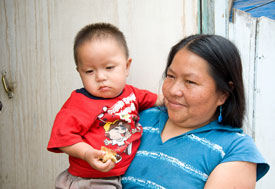A call to action: Ending preventable child death in a generation
May / June 2012 | Volume 11, Issue 3

Photo by David Snyder for Fogarty/NIH
Interventions that address neonatal conditions -
as well as continued efforts to combat
pneumonia, diarrhea and malaria - could help
reduce global child mortality.
Over the last two decades, global health and development efforts have saved the lives of more than 50 million children, half of them by preventing deaths due to pneumonia, diarrhea and measles. But much more could be accomplished with a renewed commitment and political will, urge the authors of a recent JAMA commentary, Ending Preventable Child Death in a Generation.
The improvement in under-five child mortality is partly due to establishment the U.N. Millennium Development Goals. With the 2015 MDG deadline approaching, they propose new benchmarks: that all countries should achieve a national under-five mortality rate of 20 deaths per 1,000 births by 2035, with a global average of 15 deaths per 1,000. These are achievable goals, according to data modeling, but would require the global annual rate of reduction to double from the current rate, they note.
"Success in bending the curve of childhood mortality is predicated on renewed commitment and political will as well as continued innovation in health technology and implementation science to scale solutions in a sustainable manner," the authors state.
Published to coincide with a Child Survival Call to Action conference in Washington, the essay was co-authored by Dr. Roger I. Glass, Fogarty director; Dr. Alan E. Guttmacher, director of the Eunice Kennedy Shriver National Institute of Child Health and Human Development (NICHD) at NIH; and Dr. Robert E. Black, an NIH grantee and chair of the international health department at Johns Hopkins.
While efforts must continue to combat pneumonia, diarrhea and malaria, the authors encourage implementation of interventions that focus on neonatal conditions, including preterm birth complications, intrapartum complications and severe neonatal infections. They also advocate for continued gains in reducing poverty, improving education for girls and strengthening health systems - including family planning - to reduce child mortality."
"Ending preventable child deaths is not an unreachable pipe dream," the authors suggest. "Rather, based on sound analysis to drive new commitment and more effective programming, it is an eminently achievable goal for the next generation."
More Information
- Access the full article Ending Preventable Child Death in a Generation from JAMA.
- Read the NIH Notice about the PEER Health program, Announcement of a new USAID-NIH initiative to help end preventable child deaths in developing countries: "Partnerships for Enhanced Engagement in Research (PEER) Health," released July 20, 2012.
- Learn more about the USAID Child Survival Call to Action event on June 14–15, 2012 in Washington, D.C.
- Learn more about the U.N. Millennium Development Goals (MDGs).
- Newborn Babies Account For 40% Of Preventable Child Deaths, See Little Global Health Funding, Report Says, Kaiser Family Foundation News, June 12, 2012
To view Adobe PDF files,
download current, free accessible plug-ins from Adobe's website.